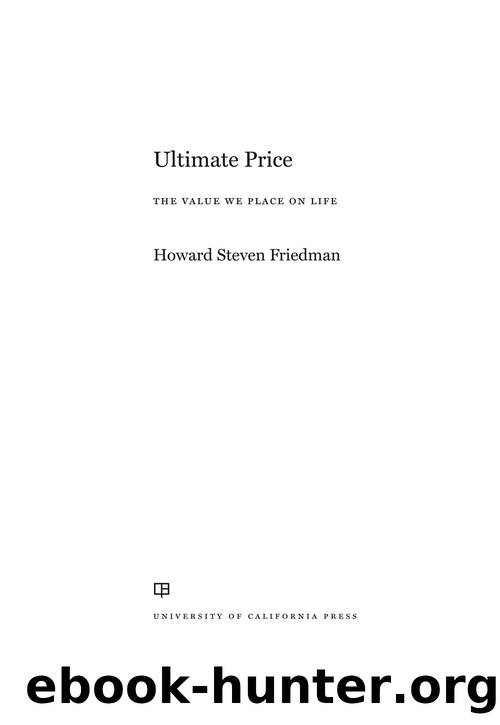Ultimate Price by Howard Steven Friedman

Author:Howard Steven Friedman
Language: eng
Format: epub
ISBN: 9780520343221
Publisher: University of California Press
METRICS AND THE RESPONSIBILITIES OF REGULATORS
Regulatory agencies are tasked with considering impacts to society and not simply looking at the bottom-line considerations that are the focus of for-profit companies’ attention. Different regulatory agencies have different perspectives on the value of health, and these perspectives influence how price tags on health are developed and used. Previously, we saw how the Value of a Statistical Life is used by environmental regulators when determining the benefits of lives saved and also of health preserved due to raising air, water and other environmental standards. These higher environmental standards can also reduce the rates of sickness, diseases, and injuries. Cost-benefit analysis for a possible new regulation needs to account for the benefits associated with the lives saved and the diseases, illnesses, and injuries prevented by the new regulation. Reduced health has a price tag associated with the value we place on avoiding suffering, pain, weakness, the inability to perform basic functions that were previously manageable, and the inability to enjoy leisure activities.
For environmental regulators to put a value on the health benefits of a new environmental standard, they need to first understand the relationship between exposure to the pollutant and the risk of a disease. When establishing an acceptable level of a poison, such as arsenic, in water, it is necessary to understand how higher levels of arsenic exposure impact people’s health, including what diseases, such as cancer and cardiovascular disease, they are more likely to contract.8 Similarly, in regulating the pollution produced by coal factories, it is necessary to understand the relationship between the key pollutants, like sulfur dioxide, and the health impacts they cause, such as bronchoconstriction and increased asthma symptoms.9 After regulators have quantified the relationship between the pollutant and diseases, they then estimate how many people will be impacted by each disease. Finally, a price on the damage to the public’s health and on the loss of life is applied.
Health technology regulators use different sets of considerations and criteria than environmental regulators when making decisions. Health technology regulators need to determine how, on a fixed budget, to save the most lives. The types of technologies they examine include drugs, devices, and health procedures such as vaccines and antibiotics, CAT scans and MRIs, and digital health technologies such as smartphone apps that track patient activity and drug compliance. When assessing the decision to invest in a health care intervention, drug, or procedure, health technology regulators take many considerations into account, including the balance of costs and benefits. Are the health benefits of the new technology worth the expense? More generally, health care planners, whether in a government or a health insurance office, need to decide if the health investment is worth the return. Regardless of which method is used for valuing the cost of health, discounting, as we have seen in many other contexts, results in favoring the health of current patients over the health of future patients. Discounting also often results in favoring curative treatments over disease prevention initiatives that can potentially delay future major health issues.
Download
This site does not store any files on its server. We only index and link to content provided by other sites. Please contact the content providers to delete copyright contents if any and email us, we'll remove relevant links or contents immediately.
The Secret History by Donna Tartt(16623)
The Social Justice Warrior Handbook by Lisa De Pasquale(11489)
Thirteen Reasons Why by Jay Asher(7788)
This Is How You Lose Her by Junot Diaz(5772)
Weapons of Math Destruction by Cathy O'Neil(5037)
Zero to One by Peter Thiel(4824)
The Myth of the Strong Leader by Archie Brown(4789)
Promise Me, Dad by Joe Biden(4447)
Beartown by Fredrik Backman(4419)
Stone's Rules by Roger Stone(4415)
How Democracies Die by Steven Levitsky & Daniel Ziblatt(4399)
The Fire Next Time by James Baldwin(4343)
100 Deadly Skills by Clint Emerson(4078)
A Higher Loyalty: Truth, Lies, and Leadership by James Comey(4033)
Rise and Kill First by Ronen Bergman(4012)
The David Icke Guide to the Global Conspiracy (and how to end it) by David Icke(3882)
The Farm by Tom Rob Smith(3872)
Secrecy World by Jake Bernstein(3782)
The Doomsday Machine by Daniel Ellsberg(3731)
